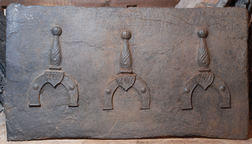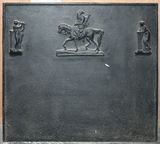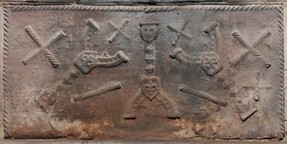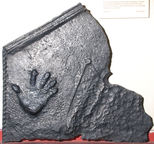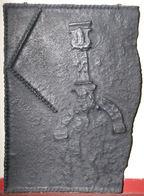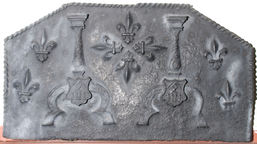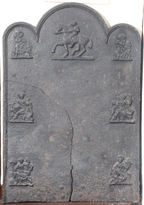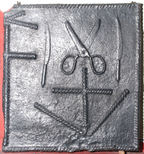-
812
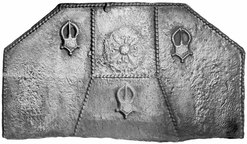 ? x ? mm
? x ? mmDescription: Canted rectangle; twisted rope edging (top and sides); divided by rope lengths into four panels: centre top, square; centre bottom, trapezium; sides, irregular hexagons; buckle stamp repeated three times, in bottom and side panels; top centre panel, circular flower stamp with fleur de lys on each petal.
Notes: The buckle stamps suggest a connection with the Pelham family; illustrated in Butterfield 1916, where it was stated to have been in a house at Herstmonceux, Sussex..
- Decoration tags:
- rectangular with canted top corners (shape)
- rope (edging)
- simple stamps
- carved stamps
- planklines
- heraldic
- objects
Manufactured: in the late-16th century in the Weald area of England.
Current location: not known.
Citation: Butterfield, W. R., 1916, 'Old Wealden Firebacks', The Connoisseur, 46, pp. 197-209.
- Attached to series:
- Pelham family firebacks
- Metalware stamp firebacks
-
1199
Description: Rectangular, plain plate; top centre, cross probably formed of a repeated length of dowel helically wrapped with a leather strap; top right, a buckle impressed four times, the top two with their prongs inclined towards each other, and the bottom two with prongs vertical and parallel; left of the cross, a shield, indented at the top, charged with a bird upon a branch, to the left of which is a 'renaissance' style shield stamp with a 'PL' monogram above two [?]bougets.
Notes: The four buckles suggest a connection with the Pelham family whose badge it is. The protrusion low on the right edge of the fireback is probably the stub of a runner through which the cast iron was run into the mould from a temporary basin formed in the casting sand. The given width dimension assumes the crack across the fireback is closed.
- Decoration tags:
- rectangular (shape)
- none (edging)
- simple stamps
- carved stamps
- heraldic
- apotropaic
- objects
Manufactured: in the early- to mid-16th century in the Weald area of England.
Current location: in private hands, Framfield, East Sussex, England.
- Attached to series:
- Bird shield series
- Pelham family firebacks
- Metalware stamp firebacks
-
166
Description: Rectangular; plain plate with three stamps of an iron firedog with a twisted design on the neck, a primitive face on the terminal and a shield bearing initials RW.
Notes: The letters RW are said to relate to Richard Woodman, ironmaster and Protestant martyr, who resided at Cralle Place, and who operated Cralle furnace. A near-identical firedog was discovered at Bridge Cottage, Uckfield, Sussex.
Inscription: RW
- Decoration tags:
- rectangular (shape)
- none (edging)
- simple stamps
- objects
Manufactured: in the mid-16th century probably at Cralle Furnace, Warbleton in the Weald area of England.
Current location: Hastings Museum and Art Gallery, John's Place, Bohemia Road, Hastings, East Sussex, England.
Museum number: HASMG: 1909.94 (part of the Hastings Museum museum group)
Citation: Butterfield, W. R., 1916, 'Old Wealden Firebacks', The Connoisseur, 46, pp. 197-209.
- Attached to series:
- Firedog stamp firebacks
- Metalware stamp firebacks
-
180
Description: Rectangular: fillet edging; top left, standing classically dressed female figure playing a lyre, with short column behind; top right, classically dressed female figure leaning on a short column; top centre, hatted figure of a bearded man with bagpipes on his back, riding a horse.
Notes: An unusual group of stamps, possibly derived from brass chimney ornaments; the middle figure seems to have little in common with the other two, and the horse’s tail may include part of another figure. Formerly part of the Ade Collection (from Grove Hill, Hellingly, Sussex).
- Decoration tags:
- rectangular (shape)
- fillet (edging)
- carved stamps
- animals
- humans
Manufactured: in the late-19th to early-20th century in England.
Current location: Hastings Museum and Art Gallery, John's Place, Bohemia Road, Hastings, East Sussex, England.
Museum number: HASMG: 1952.51.66 (part of the Hastings Museum museum group)
- Attached to series:
- Ornament stamp firebacks
- Metalware stamp firebacks
-
912
Description: Rectangular; twisted rope edging (top and sides); impression of the end of a firedog repeated three times, one upright in centre, two diagonally inverted with feet angled towards top centre; a large saltire of twisted rope in each top corner, a small saltire, of twisted rope and dowel, on either side of top of central firedog; cross of twisted rope below right hand corner saltire; lower centre, two angled rope lengths either side of central firedog. At the bottom, and outside the feet of the central firedog, two excrescences formed by the pouring of the metal.
Notes: A well-preserved example with an unusual arrangement of the firedog stamp; formerly (c.1886) in the Warbill-in-Tun inn, Warbleton, Sussex.
- Decoration tags:
- rectangular (shape)
- rope (edging)
- simple stamps
- apotropaic
- objects
Manufactured: in the mid- to late-16th century in the Weald area of England.
Current location: in private hands, Heathfield, East Sussex, England.
Citation: Balcomb, J. T., Nov. 1886, 'An Extinct Sussex Art', The Art Journal, pp. 337-340.
- Attached to series:
- Firedog stamp firebacks
- Metalware stamp firebacks
-
370
Description: Fragment; left side only; twisted rope edging to left, canted moulded batten above; left hand print with dividers to its right.
Notes: An unusual combination of edging. The dividers may refer to the occupation of the person for whom this fireback was cast. Formerly in the collection of Dr C. L. Prince of Crowborough, Sussex.
- Decoration tags:
- rectangular with canted top corners (shape)
- rope and wood moulding (edging)
- simple stamps
- humans
- objects
Manufactured: in the mid- to late-16th century in the Weald area of England.
Current location: Anne of Cleves House, Southover High Street, Lewes, East Sussex, England.
Museum number: LH000.798 (part of the Sussex Archaeological Society museum group)
Citation: Anon., 30 Dec 1911, 'Sussex Backs and their Story', The Ironmonger.
Citation: Dawson, C., 1903, 'Sussex Iron Work and Pottery', Sussex Archaeological Collections, 46, pp. 1-54.
Citation: Gardner, J. S., 1898, 'Iron Casting in the Weald', Archaeologia, 56, 1, pp. 133-164.
- Attached to series:
- Hand print firebacks
- Metalware stamp firebacks
-
378
Description: Fragment (left end only); prob. rectangular; twisted rope edging; slightly angled stamp formed of the end of a firedog with semi-circular feet, and shields at the base and top of the pilaster; V-shaped arrangement of a length of twisted rope stamped twice, the point touching the left edge of the plate and one end touching the top.
Notes: Likely to have been a triple arrangement of firedog impressions.
- Decoration tags:
- rectangular (shape)
- rope (edging)
- simple stamps
- apotropaic
- objects
Manufactured: in the mid- to late-16th century in the Weald area of England.
Current location: Anne of Cleves House, Southover High Street, Lewes, East Sussex, England.
Museum number: LH000.911 (part of the Sussex Archaeological Society museum group)
- Attached to series:
- Firedog stamp firebacks
- Rope design firebacks
- Metalware stamp firebacks
-
393
Description: Rectangular with canted top corners; twisted rope edging all round except base: plain plate with two stamps of an iron firedog with twisted neck and shield bearing letters HN and crossed staples; firedogs have columnar capitals; fleur de lys stamp repeated six times, singly at each end, in star pattern in middle; stamps have twisted wreaths.
Notes: The initials HN probably refer to Henry Nevill, the crossed staples being a badge of the Nevill family. Henry Nevill occupied Mayfield furnace from about 1585 until 1599. One of two variants (see no. 742) with the same firedogs and fleurs-de-lys; other firedogs in a very similar style are known. Formerly at Holmbush Farm, Hellingly, Sussex.
Inscription: HN HN
- Decoration tags:
- rectangular with canted top corners (shape)
- rope (edging)
- simple stamps
- carved stamps
- heraldic
- text
- objects
Manufactured: in the late-16th century possibly at Mayfield Furnace in the Weald area of England.
Current location: Anne of Cleves House, Southover High Street, Lewes, East Sussex, England.
Museum number: LH000.902 (part of the Sussex Archaeological Society museum group)
Citation: Anon., 30 Dec 1911, 'Sussex Backs and their Story', The Ironmonger.
Citation: Dawson, C., 1903, 'Sussex Iron Work and Pottery', Sussex Archaeological Collections, 46, pp. 1-54.
Citation: Gardner, J. S., 1898, 'Iron Casting in the Weald', Archaeologia, 56, 1, pp. 133-164.
-
427
Description: Rectangular with three sem-circular arches on top, the middle arch higher and wider than the others; ovolo-moulded edging (top and sides); top centre, equestrian figure stamp; six small stamps of iconic figures down the sides, arranged in two columns.
Notes: An unusual fireback with stamps about 90mm high; the stamps are likely to have been cast from brass or iron mantelpiece ornaments, popular in the Victorian period. Formerly part of the J. H. Every collection.
- Decoration tags:
- rectangular with three arches (shape)
- ovolo (edging)
- carved stamps
- pictorial
- animals
- humans
Manufactured: in the 19th century in England.
Current location: Anne of Cleves House, Southover High Street, Lewes, East Sussex, England.
Museum number: 1944.24.089 (part of the Sussex Archaeological Society museum group)
- Attached to series:
- Ornament stamp firebacks
- Metalware stamp firebacks
-
453
Description: Rectangular; twisted rope edging; irregular arrangement of three rope lengths at top left; rope cross above ‘V’ at middle bottom; impression of a pair of scissors between two impressions of a domestic table knife.
Notes: The knife is early-17th century in date or perhaps a bit earlier, just into Elizabeth I’s reign. The pommels date them from around this time and the long and narrow blades are right for the end of Elizabeth/early James I. The irregular rope lengths suggest this is probably part of a larger fireback.
- Decoration tags:
- rectangular (shape)
- rope (edging)
- simple stamps
- apotropaic
- objects
Manufactured: in the late-16th to early-17th century in the Weald area of England.
Current location: Anne of Cleves House, Southover High Street, Lewes, East Sussex, England.
Museum number: LH000.939 (part of the Sussex Archaeological Society museum group)
Citation: Moore, S., 1999, Cutlery for the Table (Sheffield, The Hallamshire Press).

